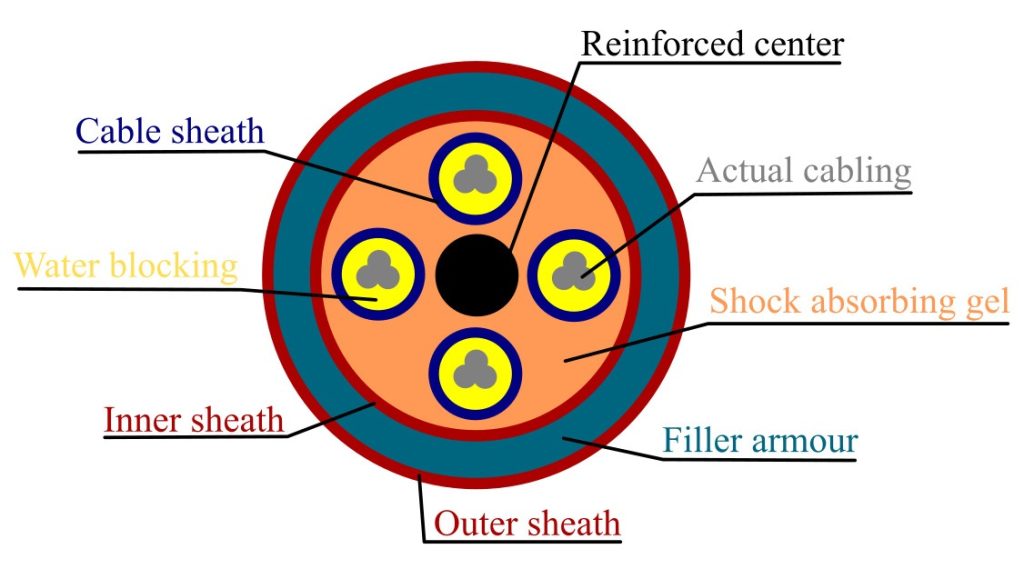Guide to Running Landscape Lighting Wire: Maximum Distance Explored
The Luminary Charm: An Overview of Landscape Lighting
Landscape lighting is a remarkable blend of art and science that accentuates the beauty of outdoor spaces, playing an integral role in exterior design. This subtle yet powerful tool not only brings architectural features to life but also adds a layer of security by illuminating dark corners. At its heart, landscape lighting is about painting with light, creating an enchanting ambiance while highlighting the property’s best features.
The magic of landscape lighting lies in its ability to transform ordinary spaces into extraordinary visual experiences. Whether it’s the soft glow on a garden path, the dramatic shadow effects on walls, or accent lights enhancing the texture of trees – every facet has a story to tell. It’s an orchestra where every light fixture plays its part harmoniously, contributing to an overall symphony.
That said, landscape lighting isn’t just about placing random fixtures around your yard and hoping they look good. It involves careful planning and execution. The positioning of lights, choosing proper fixtures for different areas and tasks, understanding color temperatures for desired mood settings – these are all factors that require careful attention.
Moreover, working with outdoor elements adds another layer of complexity – weather conditions can impact durability, while varying natural light conditions can affect visibility and lighting effectiveness. Yet when done right, landscape lighting can transform gardens into romantic nighttime venues or your housefront into a majestic spectacle.
The Enlightening Backbone: Significance of Proper Wiring in Landscape Lighting
Underneath this dazzling world lies the nuts and bolts mechanism – the wiring – akin to roots beneath beautiful blossoms. Wiring lays out the invisible map connecting individual lights into one cohesive system; it is quite literally what keeps the lights on!
Proper wiring ensures seamless transmission of electrical current from source to destination – from transformers to each light fixture in your garden or courtyard. While not as glamorous as selecting stylish fixtures or planning creative lightscapes, its importance in a well-functioning, durable landscape lighting setup cannot be overstated.

Incorrect or subpar wiring can lead to numerous problems. Flickering lights, intermittent operation, and premature bulb burnout are just some of the issues indicative of poor wiring.
More importantly, it poses safety risks – fire hazards being the gravest concern, especially in areas prone to dry spells or wildfires. However, beyond simply transferring power, meticulous wiring design helps control brightness levels and allows custom light arrangements – think dimming pathways while accentuating a majestic fountain.
It is this hidden engineering that facilitates creative expression while maintaining practicality and safety. In essence, mastering the wiring intricacies allows you to navigate through potential issues upfront and ensures that your beautifully lighted landscape doesn’t just flicker out one night unexpectedly.
The Stretch of Luminescence: How Far Can We Run the Landscape Lighting Wire?
This brings us to the central question: how far can we run the landscape lighting wire? Is there an optimal distance beyond which our lights will grow dim or cease functioning altogether? The answers lie within understanding a few key concepts about electrical circuits and how they behave over distances.
Power loss due to resistance – known as voltage drop – is one such concept that directly affects how far you can extend your landscape lighting wire without compromising on light quality. In simple terms, longer wires mean more resistance, which translates into greater power loss along the length of the wire – something that needs careful consideration during both planning and installation phases.
Another aspect is load capacity – the total amount of power drawn by all light fixtures serviced by a single transformer – which again has implications on allowable wire length. Overloading circuits not only affects performance but may also damage components or pose safety concerns.
Determining “how far” isn’t as straightforward as it may initially seem but rests on several interlinked factors, including voltage drop considerations and load capacity limitations, amongst others. In the upcoming sections, we delve deeper into these concepts and how you can plan your landscape lighting wire run effectively and safely.
Understanding Landscape Lighting Wiring Basics: Highlighting the Conduits of Your Outdoor Displays
As we set the stage for an in-depth discussion about landscape lighting wire lengths, it is essential first to comprehend what landscape lighting wire is and its purpose. Landscape lighting wire, usually buried underground, is the lifeblood of your exterior lighting. It facilitates the flow of electricity from the power source (commonly a transformer) to each individual light fixture in your landscape. Without these integral conduits, your outdoor aesthetic vision would remain quite literally in the dark.
The Backbone of Beauty: Different Types of Wire Used in Landscape Lighting
Just as there are numerous types of lights to enhance your outdoor scenes, there are also diverse wires designed to suit specific needs and applications. These include line-voltage wires, low-voltage wires, direct burial cables, and LED wires.
Firstly, line voltage wires are the standard 120-volt wires that power everyday household items like your vacuum cleaner, ceiling fan, coffee maker, and outdoor lighting. In outdoor lighting, people use line voltage circuits for floodlights and lights that require a lot of power. Line voltage wires must be buried in protective conduits to avoid damage to cables and junction boxes in the outdoors.
Secondly, low-voltage wires are predominantly used for residential landscape lighting setups owing to their safety and cost-effectiveness. They typically carry 12–24 volts – a significantly smaller amount compared to standard household voltage – thus reducing the risk of electrical shocks while also consuming less power.

Next in line are direct burial cables. As their name implies, these can be directly buried underground without requiring additional conduit for protection – an essential characteristic when navigating a diverse outdoor terrain filled with soil shifts or potential rodent issues.
And we have LED wires that cater specifically to LED lights – a popular choice due to their energy efficiency and longevity. These wires often have special considerations for voltage drop and polarity that differentiate them from conventional wiring methods.
Knots on a String: Factors Affecting Choice of Wire
When selecting a proper wire for landscape lighting, certain factors come into play that influence this decision-making process. The first consideration revolves around your light fixtures’ wattage requirements – the higher they are collectively, the thicker (or lower gauge number) your wire needs to be to accommodate this power.
The total distance from your transformer to each light also plays a significant role. Longer runs require thicker wires to mitigate voltage drop – a phenomenon we will delve into later.
Environmental conditions too bear weight on your choice of wire. Direct burial wires are particularly suited for harsh weather conditions and areas prone to digging animals, while LED wires are designed explicitly for LED fixtures.
Equally important are future expansion plans – if you anticipate adding more lights in the future, it’s wise to opt for a wire that can accommodate this potential additional load.
Budget restrictions come into play as well. Thicker wires with greater durability often come with higher price tags, so balancing cost with requirements becomes crucial in making an informed decision that best suits your landscape lighting needs.
The Science Behind Running Landscape Lighting Wire: Revealing the Unseen
Voltage drop plays a crucial role in determining wire length. It is a decrease in electrical potential along the path of a current flowing through an electrical circuit. Voltage drop can influence the efficiency and performance of your landscape lighting system.
Understanding voltage drop starts with understanding its relationship with light output. A significant voltage drop can cause your lights to dim, which notably reduces their effectiveness. This happens because as voltage decreases along the cable length, so does the light output.
The relationship between distance, wire gauge, and voltage drop is also essential to take into account. The longer the distance electricity has to travel (via wiring), the greater the voltage drop expected across that distance, particularly if you are using thinner gauge wire due to its higher resistance.
The capacity of your transformer and load calculation also significantly depend on how far you can run your landscape lighting wire. Transformer capacity refers to how much power it can supply, while load calculation involves figuring out how much power your lights will consume.
Practical Guidelines on Running Landscape Lighting Wire: Pathway to Brilliance
When determining standard distances for different types of lights and their respective optimal wire lengths, several factors come into play, including but not limited to light type, transformer size, and voltage requirements. To minimize voltage drops over long distances, consider using thicker wires as they offer less resistance or dividing larger lighting loads among multiple transformers.
Safety precautions when running wiring should never be overlooked either. Underground burial of wires in conduit protects them against physical damage from garden activities or pests; also, ensuring connections are watertight aids in preventing corrosion over time.
Advanced Techniques for Long Distance Landscape Wiring: Breaching New Frontiers
If you want longer runs for your landscape lights without compromising brightness or quality, consider using a voltage booster or larger transformers. These devices work by increasing the voltage supplied to your lighting circuit and thus can accommodate a longer wire run.
Another technique is using parallel wiring, which maintains consistent brightness over long distances by providing each light fixture with its own home run to the power source. The debate between series versus parallel wiring centers typically on benefits and drawbacks.

While series wiring allows for easier installation, it can result in a significant voltage drop and inconsistent lighting. Parallel wiring, on the other hand, provides consistent brightness but requires more intricate planning and installation.
Case Studies on Running Landscape Lighting Wire: Stories of Shining Success
Numerous successful long-distance landscape lighting projects demonstrate the principles discussed above in action. Among them are residential gardens where lights maintain their brilliance despite being situated at vast distances from the transformer. The lessons learned from these case studies often revolve around meticulous planning, understanding electrical principles such as voltage drop and load calculation, and using quality materials suited for the task at hand.
Common Mistakes when Running Landscape Lighting Wire: Averting Dim Disasters
Overloading a circuit with too many lights or too much wattage is a typical mistake made when running landscape lighting wires, which can lead to overheating or, worse, fires. Another common mistake involves using incorrect or low-quality wires that degrade over time or offer excessive resistance, thereby causing dim lighting or complete failure of fixtures.
Ignoring future possibilities like adding more lights later also figures among usual errors made during landscape light installation. It pays off in foresight to leave room for expansion within your layout and electrical capacity.
Conclusion: How Far Can We Run the Landscape Lighting Wire?
Installing landscape lighting is undoubtedly an intricate process laden with potential pitfalls, partly due to how far you can run your wire. However, armed with knowledge about electrical principles like voltage drop and transformer capacity, practical techniques like choosing appropriate wires, safety precautions, plus insights gained from case studies, you can confidently guide yourself towards achieving that perfectly lit landscape. Thus, even the longest runs in your landscape lighting wire can become pathways to a brighter, safer, and more beautiful outdoor space.
You may also be interested in the following posts:
